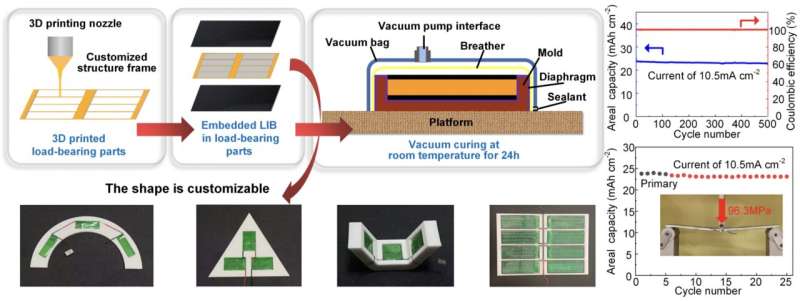August 19, 2024 feature
This article has been reviewed according to Science X's editorial process and policies. Editors have highlighted the following attributes while ensuring the content's credibility:
fact-checked
trusted source
proofread
3D-printed decoupled structural lithium-ion batteries that are stable, robust and customizable

The widespread adoption of electric vehicles greatly relies on the development of robust and fast-charging battery technologies that can support their continuous operation for long periods of time. One proposed energy storage solution to improve the endurance of electric vehicles entails the use of so-called structural batteries.
Structural batteries are batteries that can serve two purposes, acting both as structural components of vehicles and energy storage solutions. Instead of being external components that are added to an electronic or electric device, these batteries are thus directly embedded into the structure.
Researchers at Shanghai University and their collaborators recently devised a promising strategy to fabricate highly performing structural batteries with customizable geometric configurations. Their strategy, outlined in a paper published in Composites Science and Technology, enables the 3D-printing of structural lithium-ion batteries for different geometrical configurations.
"This study aims to design an integrated energy storage and load-bearing structure with high load-bearing capacity and high energy storage," Yinhua Bao, corresponding author of the paper, told Tech Xplore.
"In terms of designing structural energy storage, material science mainly focuses on the synthesis and utilization of materials, as well as the secondary design of the components for energy storage.
"For example, carbon fiber frameworks or glass fiber frameworks can be utilized, and modifications can be made to the battery electrodes, separators, or electrolytes to enhance the load-bearing performance of the structural energy storage."
Despite their potential advantages, many previously fabricated structural energy storage solutions were found to have significant limitations. These include relatively low energy densities and poor electro-mechanical cycling performance.
As part of their study, Bao and his colleagues set out to fabricate better performing structural batteries using a scalable fabrication strategy. They specifically explored the possibility of fabricating these batteries using 3D printing, which is now widely used to manufacture various products and electronic components.
"By leveraging 3D printing, we aim to create customizable structural frameworks that, when combined with energy storage materials, form components with integrated energy storage and load-bearing functions, featuring high energy density and load-bearing capacity," Bao said.
"The structural framework is intended to play the primary load-bearing role, minimizing or reducing damage to the energy storage materials during loadbearing, thereby ensuring excellent energy storage capacity."
The structural framework introduced by Bao and his colleagues could be adapted to enable the 3D printing of structural batteries for varying applications, reaching beyond electric vehicles. In fact, it could also be used to produce structural energy storage components for specific autonomous robots and warehouse logistics vehicles.
The 3D printing strategy devised by the researchers focuses on two key aspects of structural lithium-ion batteries. These are the energy storage unit and structural framework.
"By designing a decoupled structure, it is possible to effectively reduce the deformation of the energy storage unit under load, thereby improving the mechanical stability of the battery," Bao explained.
"We utilize 3D printing technology to create the framework, as it allows for rapid production and precise control of the structural components. We selected high-performance electrode materials and electrolytes to further enhance the energy density and cycle life of the battery."
Bao and his colleagues also simulated the damage to an energy storage unit under load using finite element software. This allowed them to optimize the structural design of the batteries to limit the predicted damage.
"We also adopt a distributed arrangement of the battery cells to prevent the drawback of overall failure due to localized damage," Bao said. "Our tests demonstrate that by adopting a decoupled structural battery design approach, it is possible to achieve structural batteries with both high energy density and load-bearing capacity as well as mechano-electrochemical robustness. Furthermore, 3D printing technology enables the creation of customizable structural batteries."
The researchers used their proposed approach to fabricate a composite structural battery sample. In initial tests, this battery was found to withstand significant tensile and bending stress, while also exhibiting a high energy density of 120Wh kg-1 and 210 Wh L-1 (3.5mA cm-2).
Notably, the battery was found to retain up to 92% of its capacity after 500 operation cycles. It also retained 98.7% of its capacity under a tensile stress of 80MPa and 97% of its capacity under a bending stress of 96.3 MPa, losing approximately 0.18% of its capacity per operation cycle.
"In practical applications, different material selections can be made for different components, and the use of finite element method simulations in real-world scenarios can optimize structural design," Bao said. "Our approach thus enables the fabrication of decoupled structural batteries to be applied across various use cases."
In the future, the 3D printing-based fabrication strategy introduced by this team of researchers could facilitate the large-scale production of highly performing structural energy storage components for a wide range of applications. These could include high capacity and stable structural batteries for electric vehicles, as well smaller scale batteries for robotic systems.
"The next step in our research will be to explore the application of decoupled structural batteries, such as unmanned aerial vehicles (UAVs) and robots," Bao added. "We are going to make it more reliable by changing the material of structural frameworks."
More information: Xu Ma et al, Customizable 3D-printed decoupled structural lithium-ion batteries with stable cyclability and mechanical robustness, Composites Science and Technology (2024). DOI: 10.1016/j.compscitech.2024.110783
© 2024 Science X Network

















